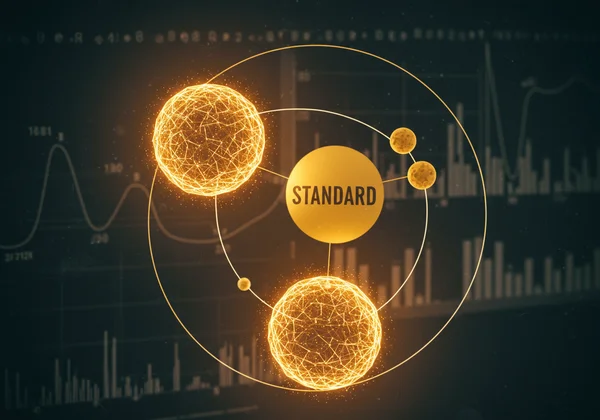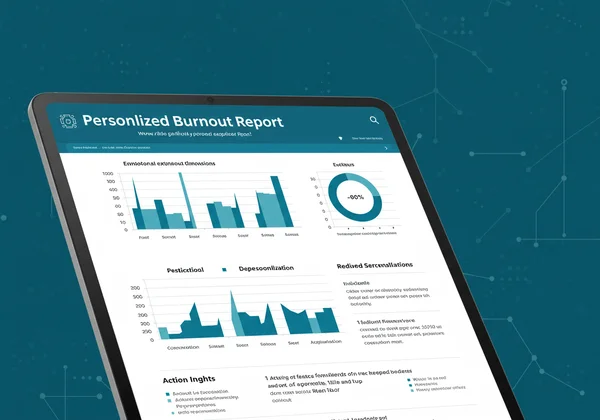The MBI: Science Behind Your Burnout Test
Feeling drained, disconnected, and perpetually exhausted? You might be asking, "Am I stressed, or is this burnout?" Getting real answers means looking beyond generic online quizzes. This article explores the science of the Maslach Burnout Inventory (MBI), the respected framework behind our free, anonymous Burnout Test, offering you genuine insight.
The difference between a helpful tool and a waste of time lies in its scientific foundation. The MBI isn't just another questionnaire; it's a meticulously developed instrument designed to measure occupational burnout accurately. By understanding its principles, you can trust the results you receive and take meaningful steps forward. Ready to see how science can illuminate your experience? You can take our free Burnout Test anytime to get started.
What is the Maslach Burnout Inventory (MBI)?
The Maslach Burnout Inventory (MBI) is widely regarded by psychologists and researchers as the leading measure of burnout. Developed by social psychologists Christina Maslach and Susan E. Jackson in the early 1980s, it was the first tool designed specifically to assess and quantify the complex experience of occupational burnout. Its creation marked a turning point, shifting the conversation from a vague notion of work-related exhaustion to a measurable psychological syndrome.
Before the MBI, there was no standardized way to self-assess burnout. The MBI provided a reliable framework that has since been used in thousands of studies across various professions and countries, solidifying its reputation. It provides a structured way to understand the multifaceted nature of burnout, moving beyond the simple idea of being "tired of work." This scientific rigor is why it forms the foundation of any credible burnout assessment.

A Brief History & Evolution of Burnout Assessment Tools
The journey to understanding burnout began in the 1970s, but it was largely anecdotal. The development of the MBI introduced a systematic, evidence-based approach. Early versions focused on human services and education professionals, but its relevance quickly became apparent across all sectors. Over the years, different versions of the MBI were developed to cater to various populations, including the MBI-General Survey (MBI-GS), which is applicable to any occupation.
This evolution of burnout assessment tools highlights a critical point: a reliable assessment must be grounded in extensive research and validation. The MBI's endurance and widespread adoption are testaments to its effectiveness. It remains the benchmark against which other tools are often measured, providing a common language for discussing and tackling workplace stress.
Why the MBI is the Gold Standard for Burnout Assessment
The MBI is considered the gold standard for several key reasons. First, it has extensive empirical support, having been validated in countless peer-reviewed studies over four decades. This means its ability to measure what it claims to measure—burnout—is well-established and reliable. When you answer questions based on its principles, you are participating in a process rooted in scientific discovery.
Second, its multidimensional approach provides a nuanced picture. Instead of giving a single "burnout score," it assesses three distinct yet related dimensions of the experience. This detailed breakdown is crucial for understanding your specific challenges and for developing targeted interventions. It’s this depth that transforms a simple score into actionable insight, a core principle we apply in our online burnout assessment.

The Three Core Dimensions of Burnout Measured by MBI
To truly understand your burnout assessment, it helps to know its core components. Many find an "aha!" moment as these pillars give specific names to feelings they've struggled to articulate, paving the way from confusion to clarity.
Each dimension captures a unique aspect of the burnout experience. Together, they create a comprehensive profile of how occupational stress is impacting your well-being, engagement, and effectiveness at work. Let's explore each one.
![]()
Emotional Exhaustion: Feeling Drained and Overwhelmed
This is the cornerstone of the burnout syndrome. Emotional exhaustion is the feeling of being overextended and depleted of one's emotional and physical resources. It's not just feeling tired after a long week; it's a chronic state of fatigue where you feel you have nothing left to give. Symptoms often include chronic fatigue, insomnia, and increased susceptibility to illness.
People experiencing this dimension often describe feeling "used up" at the end of the workday and lack the energy to face another. This deep sense of being drained is a primary indicator that your coping resources are overwhelmed by the demands of your job. Answering questions about this dimension helps quantify the level of burnout fatigue you may be experiencing.
Depersonalization (Cynicism): Disconnecting from Your Work
Depersonalization, also referred to as cynicism, is an attempt to put distance between yourself and your job. It's a psychological coping mechanism where an individual develops a detached, cynical, or negative attitude toward their work, colleagues, and clients. This can manifest as irritability, loss of idealism, and a tendency to view your job in a cold, uncaring way.
This dimension reflects an erosion of engagement. You might find yourself becoming more callous or emotionally hardened, treating aspects of your job as a frustrating series of tasks rather than a meaningful pursuit. Measuring depersonalization is crucial, as it captures the interpersonal and engagement-related strain of burnout. If this sounds familiar, it might be time to understand your burnout risk.
Reduced Personal Accomplishment: The Sense of Ineffectiveness
The third dimension is a feeling of reduced personal accomplishment or ineffectiveness. This involves a growing sense of inadequacy about your ability to do your job well and make a difference. Even when you achieve something, it may not bring satisfaction. This can lead to a crisis of professional confidence, where you doubt your skills and past successes.
This feeling is particularly insidious because it attacks your sense of self-worth and competence. It’s the voice that says, "I'm not making an impact anymore" or "I can't seem to get anything right." A proper assessment evaluates this dimension to understand how burnout may be affecting your professional self-esteem and sense of purpose.
How Our Burnout Test Leverages MBI Principles for Your Assessment
Understanding the MBI is one thing; applying it is another. On our platform, we have built our occupational burnout test on the foundational principles of the MBI. We believe that everyone deserves access to a tool that is not only easy to use but also scientifically credible. Our goal is to translate the robust, research-backed framework of the MBI into a practical and accessible experience for you.
This commitment means our questions are carefully designed to reflect the three core dimensions of burnout. We don’t just ask if you’re tired; we ask questions that probe the nuances of emotional exhaustion, depersonalization, and personal accomplishment. This ensures the feedback you receive is not arbitrary but is grounded in decades of psychological research.
From MBI Theory to Your Personalized Burnout Report
When you complete our assessment, your responses are analyzed through the lens of the MBI's three-dimensional model. You first receive an instant summary report that shows your risk level across these key areas. This gives you a quick, clear snapshot of your current state, directly reflecting the MBI's diagnostic structure.
For those seeking deeper insight, we offer an optional, AI-driven personalized burnout report. This report takes your scores and contextualizes them, providing insights into your specific strengths, challenges, and actionable steps tailored to your situation. This bridges the gap between knowing your scores and knowing what to do about them, transforming MBI theory into a practical guide for your well-being. You can get your free summary right after the test.

The Importance of a Validated, Anonymous, and Free Burnout Test
We believe that access to mental wellness tools should be simple and safe. That's why we emphasize three key features. Our test is validated, built upon the scientific principles of the MBI to ensure you get reliable insights. It is completely anonymous, requiring no registration or personal data, so you can answer honestly without fear of your privacy being compromised.
Finally, our core assessment is a free burnout test. Financial barriers should never prevent someone from taking the first step toward understanding their mental health. By providing a credible and accessible tool, we empower you to check in with yourself and make informed decisions about your well-being, whether that means talking to a manager, seeking professional help, or implementing new self-care strategies.
Empowering Your Path Forward with Science-Backed Insights
The modern workplace brings immense pressure, making it easy to feel overwhelmed. But your well-being isn't something to guess about. By understanding the science of the Maslach Burnout Inventory, you gain a powerful tool—a credible burnout test that empowers you to take control. It offers a structured, evidence-based language for your experience and a clear path forward. Your mental health is too important to leave to chance. Take that first informed step today.

Take the first step toward clarity and action today. Start your assessment to gain valuable, science-backed insights into your well-being.
Frequently Asked Questions About Burnout Assessments
How do you test for burnout effectively?
To test for burnout effectively, it's best to use a validated assessment tool grounded in established psychological models, like the Maslach Burnout Inventory (MBI). These tools measure the core dimensions of burnout: emotional exhaustion, depersonalization, and reduced personal accomplishment. An effective test provides a nuanced score across these areas, not just a single number, offering a clearer picture of your specific challenges.
Is Our Burnout Assessment Truly Based on the MBI?
Yes, our assessment is fundamentally based on the principles of the MBI. The questions are specifically structured to measure the three core dimensions of burnout as defined by Maslach and Jackson. We use this scientific framework to ensure our free Burnout Symptoms Test provides a reliable and meaningful snapshot of your risk level, making it a trustworthy first step in self-assessment.
What can burnout be mistaken for, and how does MBI help differentiate?
Burnout is often mistaken for stress or depression. While stress is characterized by over-engagement and urgency, burnout is defined by disengagement and emotional exhaustion. The MBI helps differentiate because it specifically measures job-related cynicism and a sense of ineffectiveness, which are unique hallmarks of occupational burnout. A science-backed assessment can help clarify if your feelings are tied to this specific workplace syndrome.
What is the best burnout assessment tool available online?
The best burnout assessment tool is one that is scientifically validated, anonymous, and provides actionable insights. While many tools exist, those based on the MBI are considered the gold standard. Our platform offers a compelling option because it combines the MBI's proven principles with the accessibility of a free, anonymous online platform and the added value of optional AI-powered personalized reports for deeper understanding.